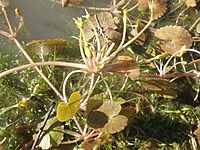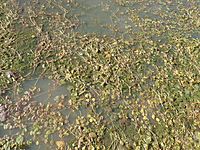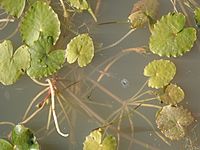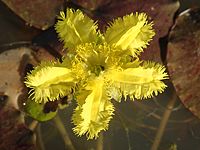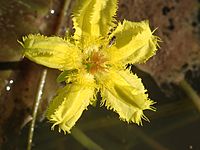Wavy marshwort facts for kids
Quick facts for kids Wavy marshwort |
|
|---|---|
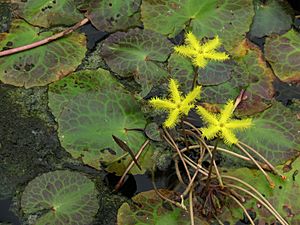 |
|
| Scientific classification | |
| Genus: |
Nymphoides
|
| Species: |
crenata
|
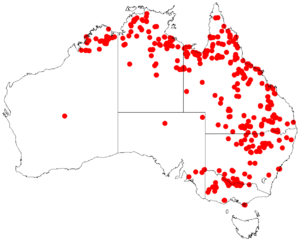 |
|
| Occurrence data from AVH | |
| Synonyms | |
|
Limnanthemum crenatum F.Muell. |
|
Nymphoides crenata, also known as wavy marshwort, is a special water plant. It's a perennial herb, which means it lives for more than two years. This plant is found only in Australia. You can spot it in all the mainland states and the Northern Territory. It belongs to the plant family called Menyanthaceae.
Contents
What Does Wavy Marshwort Look Like?
The wavy marshwort is a floating plant. It has long stems that can grow up to 3 meters (about 10 feet) long. These stems spread out, helping the plant grow in new places.
Leaves and Stems
The leaves at the bottom of the plant have long stalks, called petioles. These stalks can be from 8 to 42 centimeters (about 3 to 16 inches) long. The main part of the leaf, called the lamina, is shaped like an egg or a circle. It has a deep heart-like shape at its base. These leaves can be from 3 to 15 centimeters (about 1 to 6 inches) long.
Leaves growing on the stem are usually smaller. Sometimes, they are shaped like a kidney.
Flowers
The flowers of the wavy marshwort are quite interesting. They have different styles, which means their male and female parts are arranged in different ways on different plants. This helps them with reproduction.
You can find 8 to 14 flowers growing together in groups. These groups are often near the stem leaves. Sometimes, the flowers grow in pairs along a short flower stalk.
The outer green part of the flower, called the calyx, is about 5.5 to 16 millimeters long. The colorful part of the flower, called the corolla, can be 20 to 50 millimeters (about 1 to 2 inches) wide. It usually has 4 petals, but sometimes it can have 4 or 6. The flower also typically has 5 stigmas, which are parts that collect pollen, but this can vary from 2 to 5.
Where Does Wavy Marshwort Live?
Wavy marshwort loves wet places! You can find it growing in many different watery spots.
It often lives on floodplains, which are flat areas near rivers that can get flooded. It also grows in swamps and lagoons. You might see it in irrigation channels, which are ditches used to carry water for farming.
This plant also likes temporary wet areas. These are places that fill with water sometimes, but then dry out. It can even grow in slow-moving streams. Wavy marshwort prefers water that is up to about 1.5 meters (about 5 feet) deep. It usually grows in mud, and it can even survive when the mud starts to dry out.
How Wavy Marshwort Got Its Name
The scientific name of the wavy marshwort is Nymphoides crenata.
The plant was first described in 1854 by a scientist named Ferdinand von Mueller. He first gave it the name Limnanthemum crenatum. Later, in 1891, another scientist named Otto Kuntze moved it to the group of plants we now call Nymphoides. This is how it got its current scientific name.
Gallery


